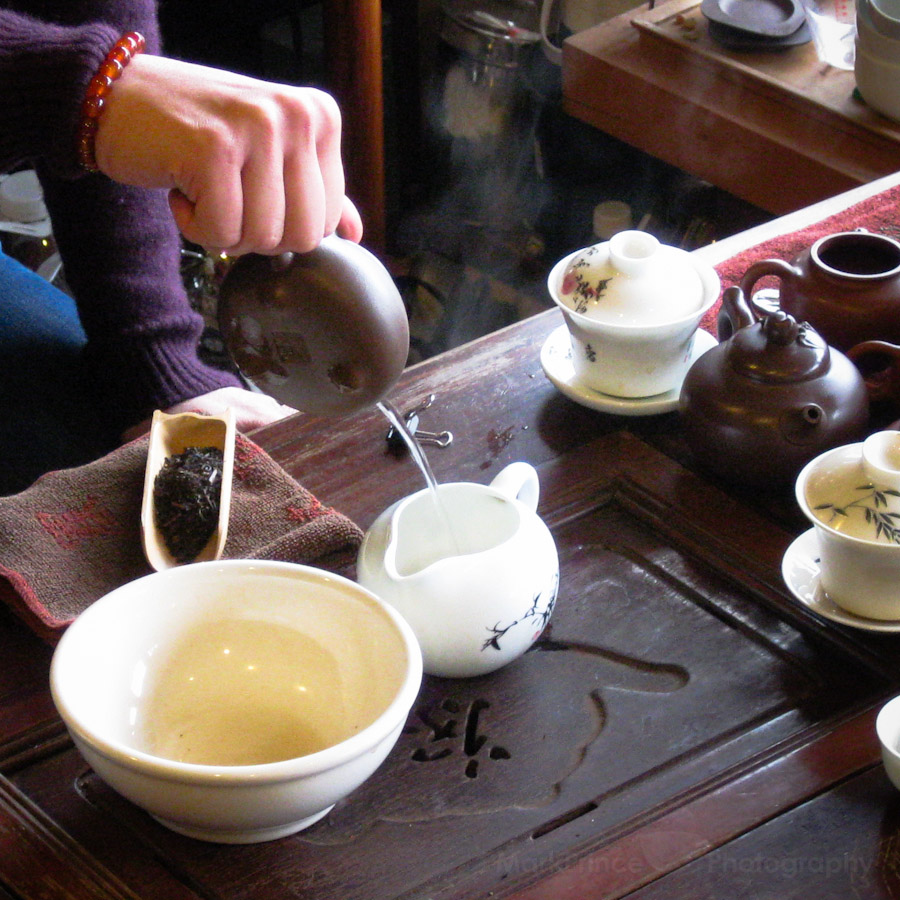Okay, I confess: I was a tea geek years before I became a CoffeeGeek. I got into tea almost by accident. I’d been looking for a decent tea to serve for a nice Chinese dinner, went into a local tea shop for some suggestions, and the rest as they say is history.
I thought I didn’t like tea, but I found out I wasn’t really drinking tea. It turns out that most tea suffers from two major faults. The first is that it is served using a tea bag. Tea bags impart a cotton-like taste, making it taste like you’re sucking on old socks. The second is that most tea has been sitting in a cardboard box for months or years and is old. Not old in the aged wine kind of way, but old as in stale and tasteless. If you’ve tried tea in a bag from a bright yellow box and didn’t like it, but you love quality coffee, you owe it to yourself to give tea another try.
As I’ve gotten into being a CoffeeGeek, I’ve found a lot of overlap between the two worlds, which are not as far apart as you’d believe. To bolster my theory that there are a lot of shared elements between the two, I met with two local tea experts to talk about the worlds of coffee and tea.
Shiuwen Tai is the owner and proprietor of Floating Leaves Tea in Seattle’s Ballard neighborhood. Her tea culture connections run deep, as she was born and raised in Taiwan, and in 2002 she started giving tea presentations to friends. She loved it so much, she became a tea importer and seller. Shiuwen is known and respected for her knowledge of Taiwanese oolong tea.

The single biggest commonality between the tea world and the coffee world is the people. I started geeking out on tea ten years ago and only recently became a CoffeeGeek. But I felt right at home reading the forums at Coffeegeek: people had the same enthusiasm, the same passion, for coffee that I had for tea (and that I later developed for coffee).
“There is a difference between a coffee drinker and a coffee person, or a tea drinker and a tea person” Brett told me.”The drinker is okay with just drinking whatever is in the cup, but the coffee or tea person is looking for something more.” He told me of his parents who don’t drink anything special in the way of coffee and don’t seek it out either. “They have a tea pot sitting in a cupboard that clearly hasn’t been used since I was last there. I ask them if they want some good tea, and mom says, ‘No thanks, dear, you go ahead.’ They just aren’t interested in trying the good stuff.”
When I asked Shiuwen about the two types of geeks, coffee and tea, she said, “Both are looking for an exquisite mouthful of liquid, some kind of flavor profile that lights them up when they drink it. In the US, people are more reserved, more solitary, than in Europe or Asia.” Shiuwen said. “When Americans drink coffee or tea, they tend to do it alone. Elsewhere it’s a social thing. There is a lot more interaction with a coffee barista, talking about neighborhood news or gossip. In Asia, it is like being in college. A couple people decide to go out for tea, a few people tag along, a few more are called on the phone, next thing you know there are twenty people showing up at a restaurant for tea, food, and conversation.”
Shiuwen told me about a friend of hers, who asked Shiuwen what image she sees when she thinks about tea? “I see a picture of my friends, riding our scooters.” Shiuwen said. “We stopped at a tea house outside Taipei City on the way back. There was lots of food, lots of tea, people talking, laughing. We were all sharing the tea and the fun times. I feel the same thing when people come in to the shop for tea. It’s why I love tea so much!”
I asked Brett the same question: what image did he see? “I see someone sipping tea, and then a big smile and contented sigh. There are no words but I can tell they’re really feeling it. It’s so satisfying when they discover a tea they like.”
When I visit Shiuwen or Brett, it’s a visit that embraces a sharing of tea, chatting with other visitors to the store, and a renewal of spirit. It’s difficult to keep up barriers when the tea is flowing and new friendships in tea are formed.

Cultivation
Our daily coffee primarily comes from two species of the coffee plant, Coffee arabica and Coffee robusta, with a few other species from other countries tossed into the mix. With tea, one species and two varietals are used: Camellia sinensis sinensis, the tea found in Pacific Rim countries, and Camellia sinensis assamica, the tea found in India. Among the two varietals are many distinctive tea plant cultivars.
A tea plant’s terroir (the variables that make up the soil and climate) plays a crucial role in shaping the tea’s flavor profile. In general, Indian assam teas come from huge, Bordeaux-like estates that strive to maintain a consistent, palate-pleasing blend for its drinkers. In China, single-farm production is the norm, with a Burgundy-like system of individual estates and farmers to produce unique teas that vary wildly with slight changes in microclimates.
Both Shiuwen and Brett have traveled in Taiwan, meeting with tea growers and vendors. Despite the language and dialect differences, they both report there is a sense of brotherhood, or of family, among the tea growers. “I was visiting one tea shop and talking with the owner,” Shiuwen said. “He asked about my travels and I said I was going to visit some tea families. He got on the phone and within five minutes he had lined up two places for me to visit. Both families were kind, generous, and proud of their farms and their tea. I wouldn’t have had such wonderful experiences if it wasn’t for our shared passion for tea!”
Processing
Coffee growers perform some coffee processing, such as sorting the cherries, but most of the coffee-processing work is done by roasters or brewers. Most Coffeegeek readers prefer to have as much of the processing done as close to home as possible.
With tea, all of the processing happens in the country of origin. Harvesting methods, heat, oxidation, rolling, and drying are used to create the six basic types of tea – white, yellow, green, oolong, black, and puerh tea. Small variations in technique result in big changes in flavor, and as with coffee the art in tea comes in knowing how to adjust the processing based on differences in the harvest.
Once processed, most tea loses freshness and flavor over time (though some teas, when processed and packaged properly, improve with time). The process isn’t as rapid as with freshly-ground coffee but tea will turn to bleh in under a year. You know those bags of tea that Grandma has in the back of her cupboard? Those were bought during the Eisenhower administration and have the flavor of dirty pocket lint. No wonder so many people say they don’t like tea; they haven’t tried the real thing.
Brett notes that there are all kinds of other teas that people may try. There are flavored teas where oils or other aromatics are added to the tea, such as bergamot added to make Earl Grey tea, and there are herbal teas made from other plants that don’t contain actual tea in them. “Many people start with a flavored tea, but then they try a green or black tea and discover a whole new world. Coffee people tend to gravitate toward oolong or puerh tea, as they often discover bolder flavors and more complexity when compared to other teas.”
Preparation

In the broadest sense, coffee and tea preparation are identical: add hot water, let sit for a bit, then serve. With coffee the devil is in the details, as anyone who tries preparing espresso at home knows. Tea preparation is easier than espresso preparation, as the temperature band is wider than for coffee and no pressurized water is required. Temperature depends on the type of tea. The least-processed tea takes the coolest water (around 60 degrees C) while the blacker teas can take boiling water. If the water is too hot, the tea tastes bitter or biting. The most common sin found at places that serve tea is taking near-boiling water straight off a hot water feed and pouring it over green tea. You can practically hear the leaves screaming in agony and you’re guaranteed a nasty, bitter cup of tea.
When the temperature is right for the type of leaves, things become interesting. Most teas benefit from multiple steepings; as the leaves absorb water and unfold, additional flavor is released into the tea broth. Unlike coffee, which is a one-and-done brewing, tea can be savored across multiple cups, as the changing flavor profile matures and blossoms.
Then there is tea culture itself. Each region has different ways to brew and serve tea, from the formal tea ceremony to simple steepings and pourings among friends. Did I mention tea gear? There are so many different tea cups, tea pots, and tea paraphernalia that any coffee or tea geek can geek out just on the glassware.
Both Shiuwen and Brett use the gongfu preparation method, which any kid at heart would enjoy—plenty of water splashing around and being poured over tea gear. Rather than a big pot and big cups, gongfu uses small pots and small cups with many, many steepings of just-right water poured over loosely-packed leaves. It means that the cup of tea is always the right amount and always the right temperature, and it’s difficult to feel full after a session of drinking tea.
Shiuwen notes that making tea isn’t about precision in temperature or timing. It’s about building a connection with the tea, the water, and the people. “Building connections is a Tao concept and it plays a big part in Chinese tea culture. In fact, when we describe tea in Taiwan, it’s not in terms of floral notes or flavors, but the feelings it generates within us.”
Exploration
I hope you’ve enjoyed a bit of geekery comparison between coffee and tea. Though weighted a bit on the tea side of the scale, I assumed most CoffeeGeeks are already familiar with coffee and so erred toward describing more about tea.
Getting into tea is fun and it doesn’t require a substantial investment in gear. For people looking to get started with tea or expand their tea horizons, here are some tips that Brett and I came up with:
- Drink a lot of tea, with other people and by yourself. You taste things differently and feel differently when you’re with other people and when you’re alone.
- Keep a tea log or tea journal. Capturing the name is enough at first, with maybe a one-to-five star rating system and the names of people you drank it with. You will be so glad you kept notes; I wish I’d kept notes about the names when I first started.
- Drink tea when you can savor it and enjoy it. Drinking tea while you’re distracted or focused on work is a waste of good tea.
- If you can, find a mentor or tea shop person that you click with. You can tell by their enthusiasm and the way they prepare tea whether they are someone you want to learn from and share tea with.
- Some teas are too good to drink alone. When you find something that excites you, share it!
- Never write off a tea until you’ve tried it three times. Your taste buds may not be feeling their best, or the tea preparation was slap-dash. Give the tea a few more tries before moving on.
Resources
If you are interested in learning more about tea, these resources will help you feed your inner tea geek:
On her Floating Leaves Tea blog, Shiuwen keeps a blog about her visits to Taiwan, her tasting notes, and news of upcoming tea tours for aficionados.
Black Dragon Tea Bar is Brett Boynton’s blog which is regularly updated with tasting notes about new tea, interesting new teaware, and other newsy items from the tea world.
Tea Lover’s Companion is a book by James Norwood Pratt and Diana Rosen. As the cover states, this gem focuses on “buying, brewing & enjoying tea.” It’s a great reference when starting out with tea and when looking for new teas to try from your favorite shop.
The Story of Tea by Mary Lou Heiss and Robert J. Heiss. This not-quite-a-coffee-table book is chock full of information, history, and pictures that illustrate tea and tea culture. It’s a great book to dip into while taking a break and sipping your favorite cuppa.
New Tea Lover’s Treasury by James Norwood Pratt. His briefer but punchier writing covers much of the same territory as the Heiss book. Pratt is world-renowned as one of the best writers about tea in the industry.
















































